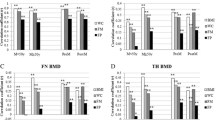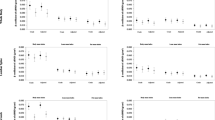Abstract
We investigated association of lean body mass with bone mass (BM) and bone mineral density (BMD) according to gender and menopausal status in the general Korean population. Participants included 4,299 males and 5,226 females who were 20 years of age or older from the fourth and fifth Korea National Health and Nutritional Examination Surveys (2009–2010). Dual-energy X-ray absorptiometry was used for measurement of BMD and body composition. BMD was measured in the femur and lumbar spine. Appendicular skeletal muscle mass (ASM) was defined as the sum of the lean soft tissue masses for the arms and legs. Analysis was performed after categorizing participants into four groups (males <50 years, males ≥50 years, premenopausal females, and postmenopausal females). In males, the highest ASM was observed in the 20–29-year group and then showed a gradual decrease as age increased, and BM and BMD showed similar patterns of change, while in females, ASM, BMD, and BM reached the peak level in the 40–49-year group and then decreased. In multiple regression analysis, after adjusting for confounding factors, the results showed an independent association of ASM with an increase in BM and BMD (P < 0.05). After adjusting for confounding factors, total fat mass showed a significant association with BM (P < 0.05). These aforementioned relationships were commonly observed on both femur and lumbar spine in every group. Lean body mass showed an independent association with increased BM and BMD, regardless of gender, age in men, and menopausal status in women.

Similar content being viewed by others
References
Consensus development conference: diagnosis, prophylaxis, and treatment of osteoporosis. Am. J. Med. 94, 646–650 (1993)
C. Cooper, E.J. Atkinson, S.J. Jacobsen, W.M. O’Fallon, L.J. Melton 3rd et al., Population-based study of survival after osteoporotic fractures. Am. J. Epidemiol. 137, 1001–1005 (1993)
I.H. Rosenberg, Sarcopenia: origins and clinical relevance. J. Nutr. 127, 990S–991S (1997)
J.E. Morley, R.N. Baumgartner, R. Roubenoff, J. Mayer, K.S. Nair, Sarcopenia. J. Lab. Clin. Med. 137, 231–243 (2001)
B.H. Goodpaster, S.W. Park, T.B. Harris, S.B. Kritchevsky, M. Nevitt et al., The loss of skeletal muscle strength, mass, and quality in older adults: the health, aging and body composition study. J. Gerontol. A Biol. Sci. Med. Sci. 61, 1059–1064 (2006)
K.E. Ensrud, S.K. Ewing, B.C. Taylor, H.A. Fink, K.L. Stone et al., Frailty and risk of falls, fracture, and mortality in older women: the study of osteoporotic fractures. J. Gerontol. A Biol. Sci. Med. Sci. 62, 744–751 (2007)
N. Binkley, A perspective on male osteoporosis. Best Pract. Res. Clin. Rheumatol. 23, 755–768 (2009)
G. Mazziotti, J. Bilezikian, E. Canalis, D. Cocchi, A. Giustina, New understanding and treatments for osteoporosis. Endocrine 41(1), 58–69 (2012)
E. Seeman, J.L. Hopper, N.R. Young, C. Formica, P. Goss et al., Do genetic factors explain associations between muscle strength, lean mass, and bone density? A twin study. Am. J. Physiol. 270, E320–E327 (1996)
H. Blain, A. Jaussent, E. Thomas, J.P. Micallef, A.M. Dupuy et al., Appendicular skeletal muscle mass is the strongest independent factor associated with femoral neck bone mineral density in adult and older men. Exp. Gerontol. 45, 679–684 (2010)
A. Coin, E. Perissinotto, G. Enzi, M. Zamboni, E.M. Inelmen et al., Predictors of low bone mineral density in the elderly: the role of dietary intake, nutritional status and sarcopenia. Eur. J. Clin. Nutr. 62, 802–809 (2008)
I. Zofkova, Hormonal aspects of the muscle-bone unit. Physiol. Res. 57(Suppl 1), S159–S169 (2008)
H.M. Frost, Bone’s mechanostat: a 2003 update. Anat. Rec. A Discov. Mol. Cell Evol. Biol. 275, 1081–1101 (2003)
M.R. Forwood, C.H. Turner, Skeletal adaptations to mechanical usage: results from tibial loading studies in rats. Bone 17, 197S–205S (1995)
L. Cianferotti, M.L. Brandi, Muscle-bone interactions: basic and clinical aspects. Endocrine (2013). doi:10.1007/s12020-013-0026-8
H. Sievanen, Hormonal influences on the muscle-bone feedback system: a perspective. J. Musculoskelet. Neuronal Interact. 5, 255–261 (2005)
S.M. Pluijm, M. Visser, J.H. Smit, C. Popp-Snijders, J.C. Roos et al., Determinants of bone mineral density in older men and women: body composition as mediator. J. Bone Miner. Res. 16, 2142–2151 (2001)
P.S. Genaro, G.A. Pereira, M.M. Pinheiro, V.L. Szejnfeld, L.A. Martini, Influence of body composition on bone mass in postmenopausal osteoporotic women. Arch. Gerontol. Geriatr. 51, 295–298 (2010)
D.R. Taaffe, J.A. Cauley, M. Danielson, M.C. Nevitt, T.F. Lang et al., Race and sex effects on the association between muscle strength, soft tissue, and bone mineral density in healthy elders: the Health, Aging, and Body Composition Study. J. Bone Miner. Res. 16, 1343–1352 (2001)
H. Blain, A. Vuillemin, A. Teissier, B. Hanesse, F. Guillemin et al., Influence of muscle strength and body weight and composition on regional bone mineral density in healthy women aged 60 years and over. Gerontology 47, 207–212 (2001)
S. Verschueren, E. Gielen, T.W. O’Neill, S.R. Pye, J.E. Adams et al., Sarcopenia and its relationship with bone mineral density in middle-aged and elderly European men. Osteoporos. Int. 24, 87–98 (2013)
S. Kirchengast, J. Huber, Sex-specific associations between soft tissue body composition and bone mineral density among older adults. Ann. Hum. Biol. 39, 206–213 (2012)
C.G. Gjesdal, J.I. Halse, G.E. Eide, J.G. Brun, G.S. Tell, Impact of lean mass and fat mass on bone mineral density: The Hordaland Health Study. Maturitas 59, 191–200 (2008)
S. Lim, H. Joung, C.S. Shin, H.K. Lee, K.S. Kim et al., Body composition changes with age have gender-specific impacts on bone mineral density. Bone 35, 792–798 (2004)
J.F. Aloia, A. Vaswani, R. Ma, E. Flaster, To what extent is bone mass determined by fat-free or fat mass? Am. J. Clin. Nutr. 61, 1110–1114 (1995)
S. Khosla, E.J. Atkinson, B.L. Riggs, L.J. Melton III, Relationship between body composition and bone mass in women. J. Bone Miner. Res. 11, 857–863 (1996)
S. Gillette-Guyonnet, F. Nourhashemi, S. Lauque, H. Grandjean, B. Vellas, Body composition and osteoporosis in elderly women. Gerontology 46, 189–193 (2000)
H.S. Choi, H.J. Oh, H. Choi, W.H. Choi, J.G. Kim et al., Vitamin D insufficiency in Korea—a greater threat to younger generation: the Korea National Health and Nutrition Examination Survey (KNHANES) 2008. J. Clin. Endocrinol. Metab. 96, 643–651 (2011)
Y. Kim, B.K. Lee, Associations of blood lead, cadmium, and mercury with estimated glomerular filtration rate in the Korean general population: analysis of 2008–2010 Korean National Health and Nutrition Examination Survey data. Environ. Res. 118, 124–129 (2012)
Korea Centers for Disease Control and Prevention 2012 Korea National Health and Nutrition Examination Survey. http://Knhanes.cdc.go.kr/. Accessed 25 Mar 2013
S.B. Heymsfield, R. Smith, M. Aulet, B. Bensen, S. Lichtman et al., Appendicular skeletal muscle mass: measurement by dual-photon absorptiometry. Am. J. Clin. Nutr. 52, 214–218 (1990)
S. Lim, J.H. Kim, J.W. Yoon, S.M. Kang, S.H. Choi et al., Sarcopenic obesity: prevalence and association with metabolic syndrome in the Korean Longitudinal Study on Health and Aging (KLoSHA). Diabetes Care 33, 1652–1654 (2010)
M. Muscaritoli, S.D. Anker, J. Argiles, Z. Aversa, J.M. Bauer et al., Consensus definition of sarcopenia, cachexia and pre-cachexia: joint document elaborated by Special Interest Groups (SIG) “cachexia-anorexia in chronic wasting diseases” and “nutrition in geriatrics”. Clin. Nutr. 29, 154–159 (2010)
I. Janssen, S.B. Heymsfield, R. Ross, Low relative skeletal muscle mass (sarcopenia) in older persons is associated with functional impairment and physical disability. J. Am. Geriatr. Soc. 50, 889–896 (2002)
K.K. Hedayati, M. Dittmar, Prevalence of sarcopenia among older community-dwelling people with normal health and nutritional state. Ecol. Food Nutr. 49, 110–128 (2010)
R.N. Baumgartner, K.M. Koehler, D. Gallagher, L. Romero, S.B. Heymsfield et al., Epidemiology of sarcopenia among the elderly in New Mexico. Am. J. Epidemiol. 147, 755–763 (1998)
G.A. van Kan, Epidemiology and consequences of sarcopenia. J. Nutr. Health Aging 13, 708–712 (2009)
S. Lee, T.N. Kim, S.H. Kim, Sarcopenic obesity is more closely associated with knee osteoarthritis than is nonsarcopenic obesity: a cross-sectional study. Arthritis Rheum. 64, 3947–3954 (2012)
T.N. Kim, S.J. Yang, H.J. Yoo, K.I. Lim, H.J. Kang et al., Prevalence of sarcopenia and sarcopenic obesity in Korean adults: the Korean sarcopenic obesity study. Int. J. Obes. 33, 885–892 (2009)
A.B. Newman, V. Kupelian, M. Visser, E. Simonsick, B. Goodpaster et al., Sarcopenia: alternative definitions and associations with lower extremity function. J. Am. Geriatr. Soc. 51, 1602–1609 (2003)
L. Van Langendonck, A.L. Claessens, J. Lefevre, M. Thomis, R. Philippaerts et al., Association between bone mineral density (DXA), body structure, and body composition in middle-aged men. Am. J. Hum. Biol. 14, 735–742 (2002)
G.V. Halade, A. El Jamali, P.J. Williams, R.J. Fajardo, G. Fernandes, Obesity-mediated inflammatory microenvironment stimulates osteoclastogenesis and bone loss in mice. Exp. Gerontol. 46, 43–52 (2011)
P. Szulc, T.J. Beck, F. Marchand, P.D. Delmas, Low skeletal muscle mass is associated with poor structural parameters of bone and impaired balance in elderly men—the MINOS study. J. Bone Miner. Res. 20, 721–729 (2005)
Y.E. Taes, B. Lapauw, G. Vanbillemont, V. Bogaert, D. De Bacquer et al., Fat mass is negatively associated with cortical bone size in young healthy male siblings. J. Clin. Endocrinol. Metab. 94, 2325–2331 (2009)
M. Visser, D.P. Kiel, J. Langlois, M.T. Hannan, D.T. Felson et al., Muscle mass and fat mass in relation to bone mineral density in very old men and women: the Framingham Heart Study. Appl. Radiat. Isot. 49, 745–747 (1998)
T. Douchi, T. Oki, S. Nakamura, H. Ijuin, S. Yamamoto et al., The effect of body composition on bone density in pre- and postmenopausal women. Maturitas 27, 55–60 (1997)
M.C. Walsh, G.R. Hunter, M.B. Livingstone, Sarcopenia in premenopausal and postmenopausal women with osteopenia, osteoporosis and normal bone mineral density. Osteoporos. Int. 17, 61–67 (2006)
A.J. Cruz-Jentoft, J.P. Baeyens, J.M. Bauer, Y. Boirie, T. Cederholm et al., European consensus on definition and diagnosis: Report of the European working group on sarcopenia in older people. Age Ageing 39, 412–423 (2010)
Acknowledgments
This research was supported by a grant from the Daegu and Kyungpook local committee of the Korean Diabetes Association and by the Dongguk University research fund. I thank the Ministry of Health and Social Welfare and Korea Centers for Disease Control and Prevention for providing the invaluable data of the survey.
Conflict of interest
The authors have nothing to declare.
Author information
Authors and Affiliations
Corresponding author
Electronic supplementary material
Below is the link to the electronic supplementary material.
Rights and permissions
About this article
Cite this article
Moon, SS. Relationship of lean body mass with bone mass and bone mineral density in the general Korean population. Endocrine 47, 234–243 (2014). https://doi.org/10.1007/s12020-013-0160-3
Received:
Accepted:
Published:
Issue Date:
DOI: https://doi.org/10.1007/s12020-013-0160-3




